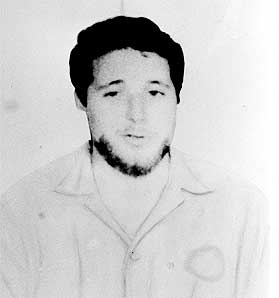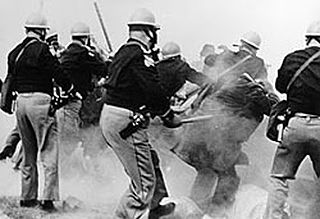
Rosa Louise McCauley Parks was an American activist in the civil rights movement best known for her pivotal role in the Montgomery bus boycott. The United States Congress has honored her as "the first lady of civil rights" and "the mother of the freedom movement".

The civil rights movement was a social movement and campaign from 1954 to 1968 in the United States to abolish legalized racial segregation, discrimination, and disenfranchisement in the country. The movement had its origins in the Reconstruction era during the late 19th century and had its modern roots in the 1940s, although the movement made its largest legislative gains in the 1960s after years of direct actions and grassroots protests. The social movement's major nonviolent resistance and civil disobedience campaigns eventually secured new protections in federal law for the civil rights of all Americans.

The Montgomery bus boycott was a political and social protest campaign against the policy of racial segregation on the public transit system of Montgomery, Alabama. It was a foundational event in the civil rights movement in the United States. The campaign lasted from December 5, 1955—the Monday after Rosa Parks, an African-American woman, was arrested for her refusal to surrender her seat to a white person—to December 20, 1956, when the federal ruling Browder v. Gayle took effect, and led to a United States Supreme Court decision that declared the Alabama and Montgomery laws that segregated buses were unconstitutional.

Medgar Wiley Evers was an American civil rights activist and the NAACP's first field secretary in Mississippi. He was assassinated by Byron De La Beckwith.

Michael Henry Schwerner was an American civil rights activist. He was one of three Congress of Racial Equality (CORE) field workers killed in rural Neshoba County, Mississippi, by members of the Ku Klux Klan. Schwerner and two co-workers, James Chaney and Andrew Goodman, were killed in response to their civil rights work, which included promoting voting registration among African Americans, most of whom had been disenfranchised in the state since 1890.

The Southern Christian Leadership Conference (SCLC) is an African-American civil rights organization based in Atlanta, Georgia. SCLC is closely associated with its first president, Martin Luther King Jr., who had a large role in the American civil rights movement.

The Selma to Montgomery marches were three protest marches, held in 1965, along the 54-mile (87 km) highway from Selma, Alabama, to the state capital of Montgomery. The marches were organized by nonviolent activists to demonstrate the desire of African-American citizens to exercise their constitutional right to vote, in defiance of segregationist repression; they were part of a broader voting rights movement underway in Selma and throughout the American South. By highlighting racial injustice, they contributed to passage that year of the Voting Rights Act, a landmark federal achievement of the civil rights movement.
The Montgomery Improvement Association (MIA) was formed on December 5, 1955 by black ministers and community leaders in Montgomery, Alabama. Under the leadership of Ralph Abernathy, Martin Luther King Jr. and Edgar Nixon, the MIA was instrumental in guiding the Montgomery bus boycott, a successful campaign that focused national attention on racial segregation in the South and catapulted King into the national spotlight.

Theodore Roosevelt Mason Howard was an American civil rights leader, fraternal organization leader, entrepreneur and surgeon. He was a mentor to activists such as Medgar Evers, Charles Evers, Fannie Lou Hamer, Amzie Moore, Aaron Henry, and Jesse Jackson, whose efforts gained local and national attention leading up to the civil rights movement of the 1960s.
The Regional Council of Negro Leadership (RCNL) was a society in Mississippi founded by T. R. M. Howard in 1951 to promote a program of civil rights, self-help, and business ownership for African Americans. It pledged "to guide our people in their civic responsibilities regarding education, registration and voting, law enforcement, tax paying, the preservation of property, the value of saving and in all things which will make us stable, qualified conscientious citizens." Instead of starting from the "grass roots," however, the strategy was to "reach the masses through their chosen leaders" by harnessing the talents of blacks with a proven record in business, the professions, education, and the church.

Robert Sylvester Graetz Jr. was a Lutheran clergyman who, as the white pastor of a black congregation in Montgomery, Alabama, openly supported the Montgomery bus boycott, a landmark event of the civil rights movement.

Johnnie Rebecca Daniels Carr was a leader in the Civil Rights Movement in the United States from 1955 until her death.

Bernard Lafayette, Jr. is an American civil rights activist and organizer, who was a leader in the Civil Rights Movement. He played a leading role in early organizing of the Selma Voting Rights Movement; was a member of the Nashville Student Movement; and worked closely throughout the 1960s movements with groups such as the Student Nonviolent Coordinating Committee (SNCC), the Southern Christian Leadership Conference (SCLC), and the American Friends Service Committee.
"Only a Pawn in Their Game" is a song written by Bob Dylan about the assassination of civil rights activist Medgar Evers in Jackson, Mississippi, on June 12, 1963. Showing support for African-Americans during the American Civil Rights Movement, the song was released on Dylan's The Times They Are a-Changin' album in 1964.
James M. Letherer, born and died in Saginaw, Michigan, better known as Jim Letherer, was an American civil rights activist. He walked on crutches the entire 54 miles of the 1965 Selma to Montgomery march for voting rights, and in 1966 walked with Martin Luther King Jr. in James Meredith's Mississippi March Against Fear. Letherer lost his right leg to cancer when he was ten years old. Letherer has received honors by the Selma to Montgomery Interpretive Center Museum in Alabama, which hosts a life-size statue of him.
With a big heart and a tenacious spirit, he trooped with King and fellow marchers in many a Deep South protest despite not having his right leg from birth. During the 1965 Selma to Montgomery march, Letherer – who used crutches – helped keep spirits high by unswervingly shouting out cadence for his remaining leg, by chanting, "Left, left, left!"
This is a timeline of the civil rights movement in the United States, a nonviolent mid-20th century freedom movement to gain legal equality and the enforcement of constitutional rights for people of color. The goals of the movement included securing equal protection under the law, ending legally institutionalized racial discrimination, and gaining equal access to public facilities, education reform, fair housing, and the ability to vote.
Brother Will Hairston was an American gospel singer and preacher in Detroit, Michigan, called "The Hurricane of the Motor City" and known for his "startlingly socially conscious" songs of protest in the 1950s and 1960s during the Civil Rights Movement.
Ralph Edwin King Jr., better known as Ed King, is a United Methodist minister, civil rights activist, and retired educator. He was a key figure in historic civil rights events taking place in Mississippi, including the Jackson Woolworth’s sit-in of 1963 and the Freedom Summer project in 1964. Rev. King held the position of chaplain and dean of students, 1963–1967, at Tougaloo College in Jackson, Mississippi. At this critical juncture of the civil rights movement, historian John Dittmer described King as “the most visible white activist in the Mississippi movement.”
The Black Christmas Boycott, also known as the Christmas Sacrifice, in Greenville, North Carolina was a non-violent demonstration of the Civil Rights Movement in 1963 during the months of November and December.











